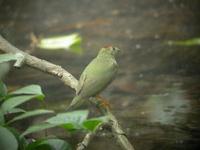|
| Query: bird | Result: 2338th of 32675 | |
A juvenile Lance-tailed Manakin (Chiroxiphia lanceolata), which is often taken for Striped Manakin (Machaeropterus regulus), a species that doesn't occur here.

| Resolution: 300x225
File Size: 9355 Bytes
Upload Date: 2008:01:31 00:07:32
|
Birding (safely) in N-Colombia
Best birding is along the main road between the entrance and Ca???averal,
the trail between Ca???averal and Arecifes and the trail that goes to
Pueblito (N 11???18,38'; W 73???58,7') , a pre-colombian village. Along this trail, one
might see Blue-billed Curassows (Crax alberti).
There is another trail that goes to the last beaches (nudist beach). These are also
good for birds (no, not only these birds!). From here there is also a trail that goes
to Pueblito. It is nearly only used for going up to Pueblito by horse.
In case you are in the dry season, try to wait in
the evening near tiny creeks, where the birds come to drink.
This way I saw nearly all birds of the past week
in an easier way. Best is the creek on the trail towards Pueblito and
the one halfway between Arecifes and Ca???averal. Along the first one I saw
some endemic
Poison-arrow Frogs
Dendrobates truncatus
).
Most special bird of the park is surely the
Lance-tailed Manakin
Chiroxiphia lanceolata |
^o^
Animal Pictures Archive for smart phones
^o^
|
|